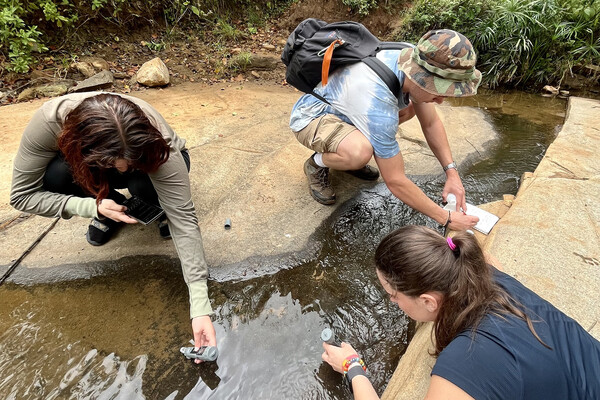
Griffin Pitt, right, works with two other student researchers to test the conductivity, total dissolved solids, salinity, and temperature of water below a sand dam in Kenya.
(Image: Courtesy of Griffin Pitt)

A new study published in Accident Analysis & Prevention shows how biometric data can be used to find potentially challenging and dangerous areas of urban infrastructure before a crash occurs. Lead author Megan Ryerson led a team of researchers in the Stuart Weitzman School of Design and the School of Engineering and Applied Science in collecting and analyzing eye-tracking data from cyclists navigating Philadelphia’s streets. The team found that individual-based metrics can provide a more proactive approach for designing safer roadways for bicyclists and pedestrians.
Current federal rules for installing safe transportation interventions at an unsafe crossing—such as a crosswalk with a traffic signal—require either a minimum of 90-100 pedestrians crossing this location every hour or a minimum of five pedestrians struck by a driver at that location in one year. Ryerson says that the practice of planning safety interventions reactively with a “literal human cost,” has motivated her and her team to find more proactive safety metrics that don’t require waiting for tragic results.
Part of the challenge, says Ryerson, is that transportation systems are designed and refined using metrics like crash or fatality data instead of data on human behavior to help understand what makes an area unsafe or what specific interventions would be the most impactful. This reactive approach also fails to capture where people might want to cross but don’t because they consider it too dangerous and that, if it were safe, more people would utilize.
“Today we have technology, data science, and the capability to study safety in ways that we didn’t have when the field of transportation safety was born,” says Ryerson. “We don’t have to be reactive in planning safe transportation systems; we can instead develop innovative, proactive ways to evaluate the safety of our infrastructure.”
The team developed an approach to evaluate cognitive workload, a measure of a person’s ability to perceive and process information, in cyclists. Cognitive workload studies are frequently used in other fields of transportation, such as air traffic control and driving simulations, to determine what designs or conditions enable people to process the information around them. But studies looking at cognitive workload in bicyclists and pedestrians are not as common due to a number of factors, including the difficulty of developing realistic cycling simulations.
The researchers in Ryerson’s lab looked at how different infrastructure designs elicit changes in cognitive workload and stress in urban cyclists. In 2018, the team had 39 cyclists travel along a U-shaped route from JFK Boulevard and Market Street, down 15th Street to 20th Street, then returning back to 15th and Market. Riders wore Tobii eye-tracking glasses equipped with inward- and outward-facing camera and a gyroscope capable of collecting eye- and head-movement data 100 times per second.
Along with the route being one of Philadelphia’s newest protected bicycle lanes at the time, and therefore a new experience for all of the study participants, it also has a dramatic change in infrastructure along the 8-10-minute route, including a mix of protected bike lanes, car-bike mixing zones, and completely unprotected areas. “We felt that, in a short segment of space, our subjects could experience a range of transportation-infrastructure designs which may elicit different stress and cogitative workload responses,” Ryerson says.
One of the study’s main findings is the ability to correlate locations that have disproportionately high numbers of crashes with a consistent biometric response that indicates increased cognitive workload. If a person’s cognitive workload is high, Ryerson says, it doesn’t necessarily mean that they will crash, but it does mean that a person is less able to process new information, like a pedestrian or a driver entering the bike lane, and react appropriately. High cognitive workload means the threat of a crash is heightened.
In addition, the researchers found that stressful areas were consistent between expert cyclists and those less experienced or confident. This has implications for current approaches to managing safety, which typically focus on pedestrian- and cyclist-education interventions. Education is still important, Ryerson says, but these results show that infrastructure design is just as important in terms of making spaces safe.
“Even if you’re a more competent cyclist than I am, we still have very similar stress and workload profiles as we traverse the city,” says Ryerson. “Our finding, that safety and stress are a function of the infrastructure design and not the individual, is a shift in perspective for the transportation-safety community. We can, and must, build safety into our transportation systems.”
The Ryerson lab is now analyzing a separate eye-tracking dataset from cyclists traveling Spruce and Pine streets before and after the 2019-20 installation of protected bike lanes, an experiment that will allow closer study of the impacts of a design intervention.
Overall, Ryerson says, the research shows that it’s possible to be more proactive about safety and that city planners could use individual-level data to identify areas where a traffic intervention might be useful—before anyone is hit by a car. “The COVID-19 pandemic encouraged so many of us to walk and bike for commuting and recreation. Sadly, it also brought an increase in crashes. We must proactively design safer streets and not wait to count more crashes and deaths. We can use the way people feel as they move through the city as a way to design safer transportation systems,” she says.
The complete author list is Megan Ryerson, Carrie Long, Michael Fichman, Joshua Davidson, Kristen Scudder, George Poon, and Matthew Harris from Penn; Michelle Kim from Swarthmore; and Radhika Katti from Carnegie Mellon University.
Megan S. Ryerson is the UPS Chair of Transportation and associate professor of city and regional planning and associate dean for research in the Stuart Weitzman School of Design at the University of Pennsylvania. She also has a secondary appointment in the Department of Electrical & Systems Engineering in the School of Engineering and Applied Science.
Carrie Long is a senior transportation planner at Gannett Fleming and a lecturer at the Stuart Weitzman School of Design. Joshua Davidson is a Ph.D. student in city and regional planning at the Weitzman School of Design. Matthew Harris is an adjunct professor and Michael Fichman is a lecturer in the Urban Spatial Analytics program in the University of Pennsylvania Weitzman School of Design.
This research was supported by the University of Pennsylvania Perelman School of Medicine’s Quartet Pilot Project and Penn’s Mobility21 National University Transportation center in partnerships with Carnegie Mellon University, which is sponsored by the U.S. Department of Transportation grant 69A3551747111.
Erica K. Brockmeier

Griffin Pitt, right, works with two other student researchers to test the conductivity, total dissolved solids, salinity, and temperature of water below a sand dam in Kenya.
(Image: Courtesy of Griffin Pitt)

Image: Andriy Onufriyenko via Getty Images

nocred

Provost John L. Jackson Jr.
nocred